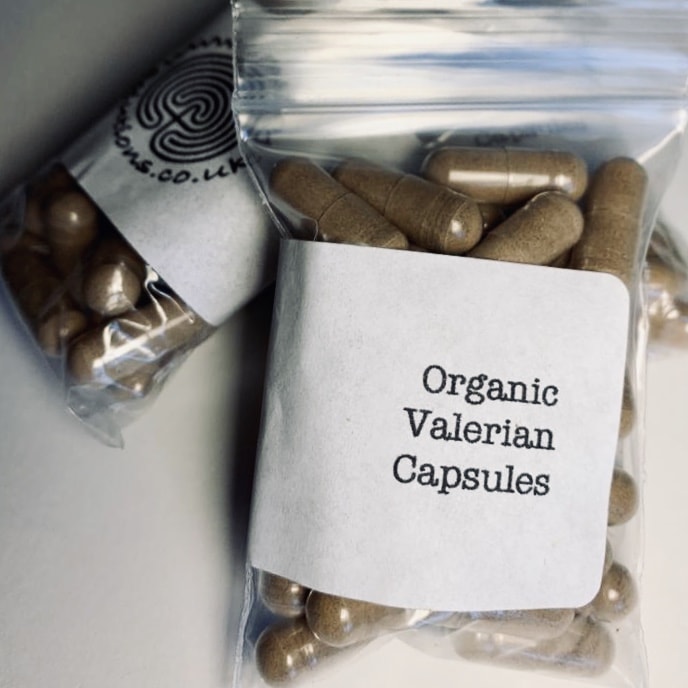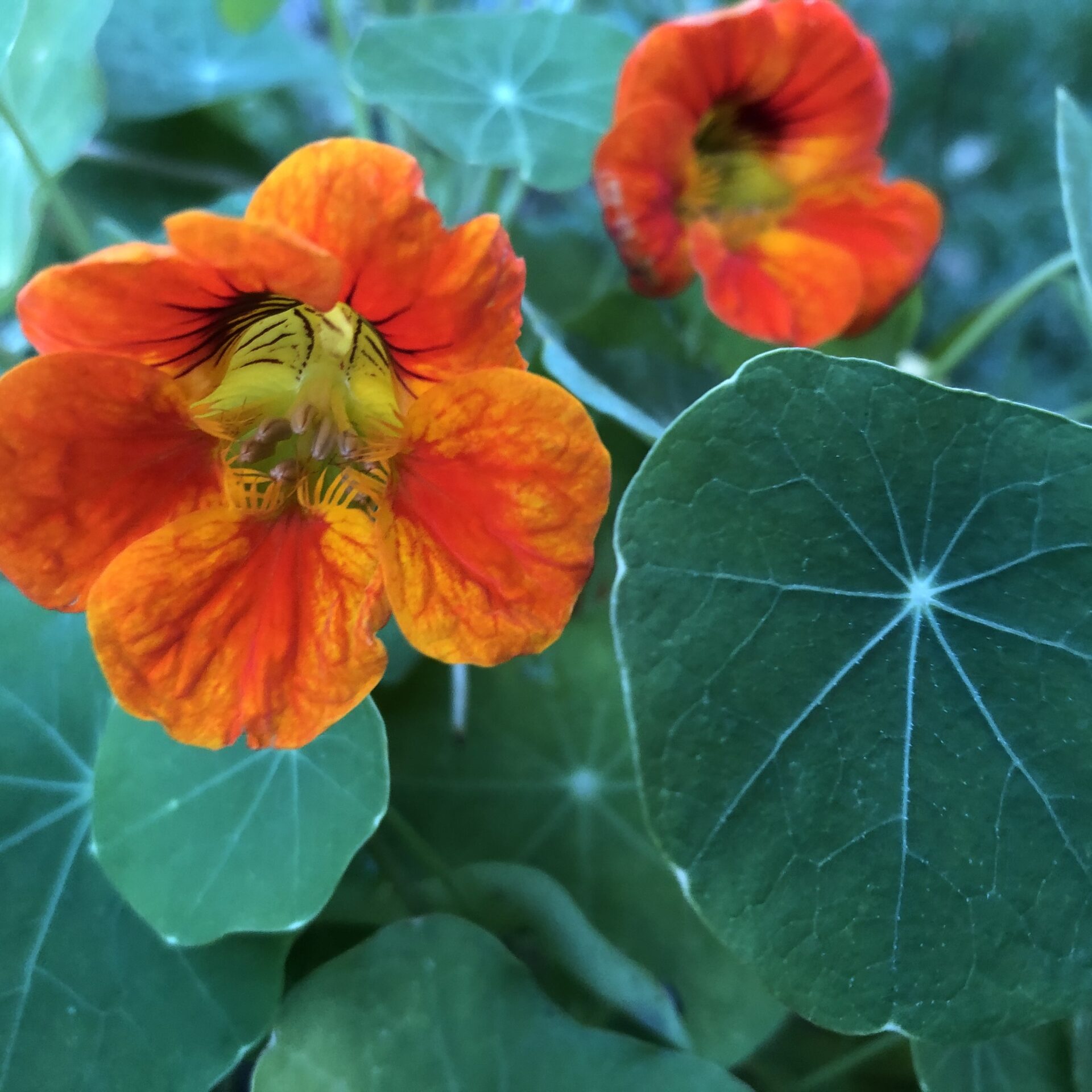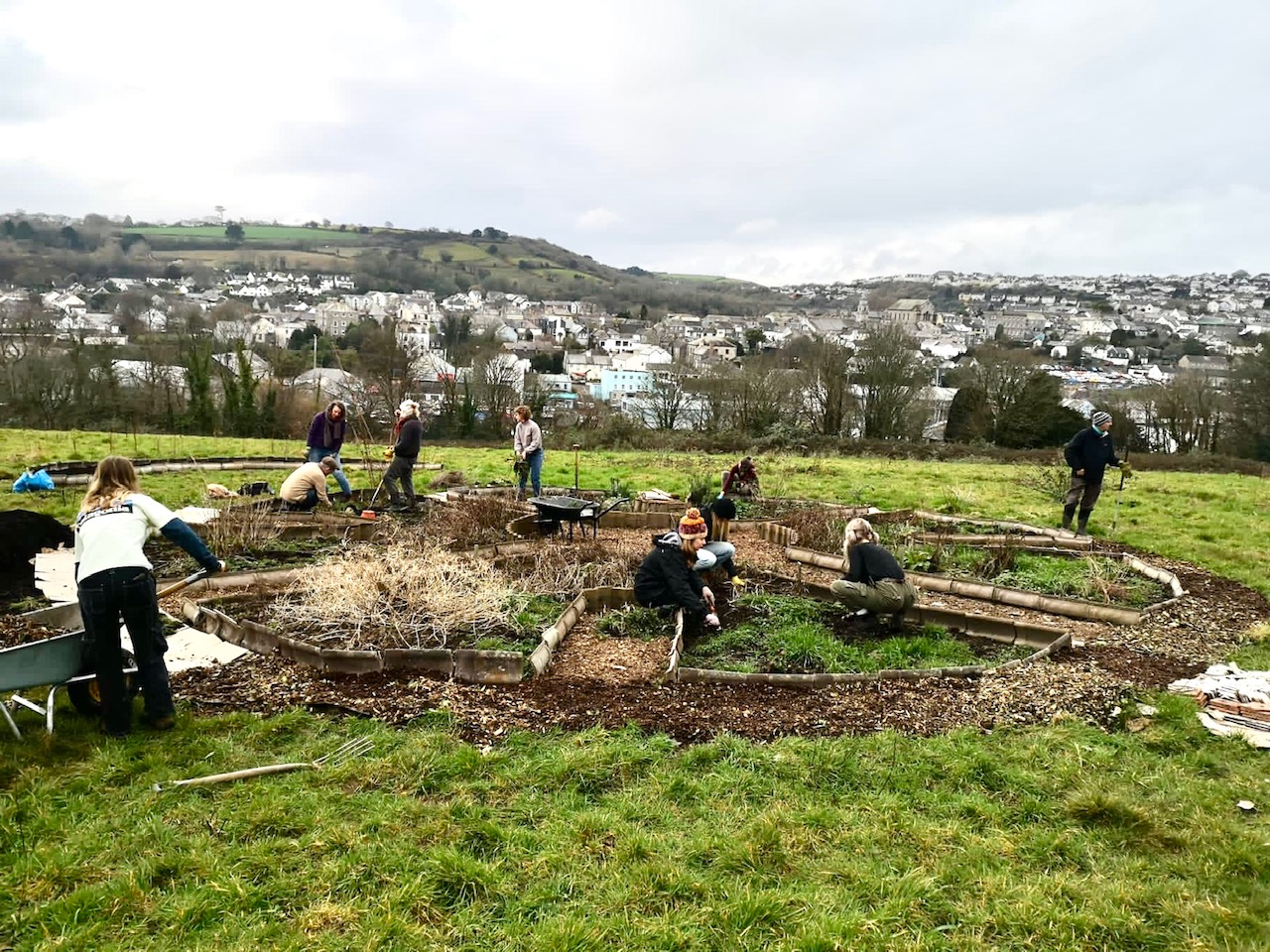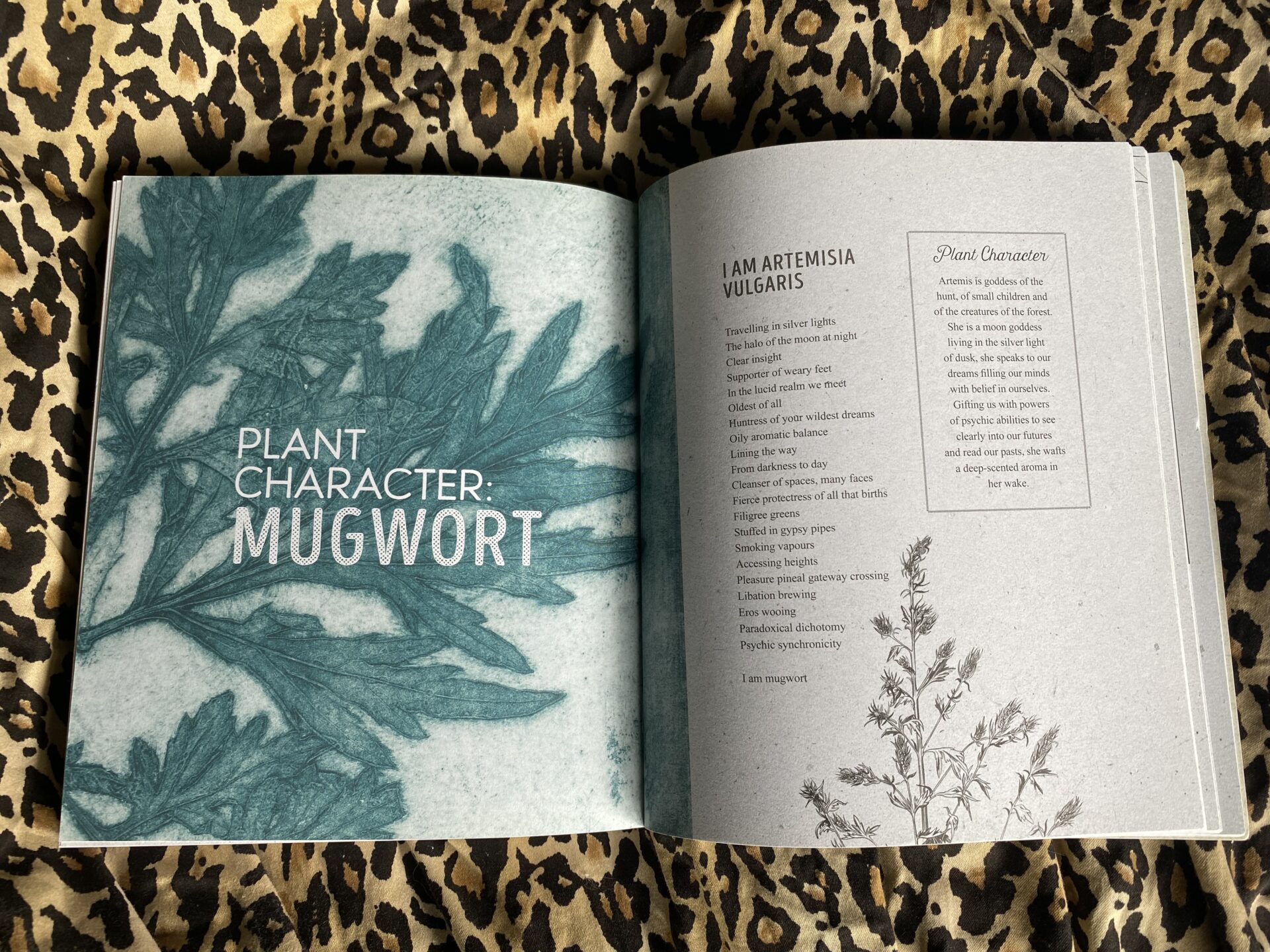VALERIAN
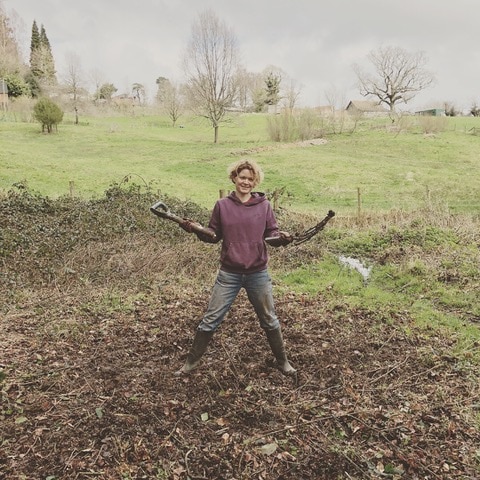
Anneliese is currently in her final year of the Sensory Herbal Apprenticeship, having been passionate about herbal healing and food as medicine for many years. She is an Internationally certified Sports Nutritionist (ISSN) and has lectured on Sport Science and Sports Nutrition for almost 20 years.
Her practice in providing nutritional interventions for athletes led her to herbal supplements to support performance and then a fascination in herbs for all round health. Once she has completed the Sensory Herbal Apprenticeship she hopes to be working with clients to provide herbal healing, leading community herbal workshops and running local herb walks.
Latin Name: Valeriana officinalis
Other Species: Marsh valerian (V. dioica) is rare and non-medicinal (6). Red valerian (Centranthus ruber) common in Britain but non-medicinal (6). Valeriana Mexicana; Valeriana pyrenaica (18). There are over 150 species worldwide (6).
Other Names: All heal; Amantilla; Cats Valerian; English Valerian; Fragrant Valerian; Garden Heliotrope; St Georges herb; Setwell; Vandal Root (2). Set all; cut finger; Phu (3). True Wild; Tobacco root; Cat herb; Mad cap (9).
Family: Valerianaceae (3, 12). Caprifoliaceace – Honeysuckle family (6).
Gender: feminine (2).
Element: Water (2). Air (19).
Planet: Venus (2), Mercury (9, 12, 18).
Key words: sedative; relaxant; anti-spasmodic; nervous-system; dilate BVs; tranquilizer.
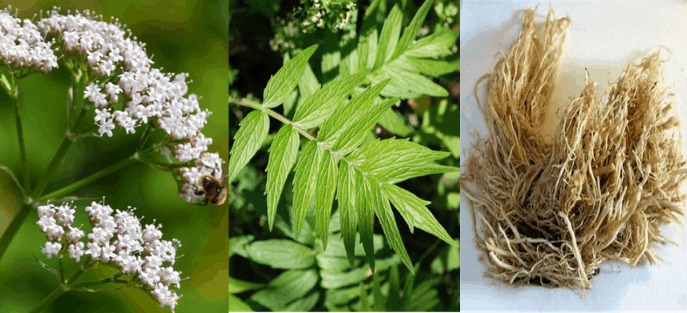
Description: a tall, hardy perennial (3), with a graceful statue (9). Sparse, erect stems with umbels (6) or Clusters of small, sweetly scented white flowers, tinged with pink in summer (3). The large head of flowers resembles an umbellifer, but it is unrelated to them (13). The feathered, pinnate (9) leaf are opposite (6). Each leaf is made up of a series of lance-shaped segments, more or less opposite each-other on either side of the leaf, with leaflets varying from 6-10 pairs (18). The stem is hollow and furrowed (9). The white-pink flowers have a vanilla-like odour, which becomes heady in colonies of flowers (6). The root is brown, white inside, with many tendrils (9) and is highly scented and often discussed in terms of disgust with descriptions such as Tom cat urine, old socks, and nauseatingly unpleasant (6). It stimulates earthworm activity and supports the growth of nearby plants (7). The more the root stinks the higher it is in the volatile oils, that hold the relaxing qualities (12).
Parts Used: root, rhizome (3). Flowers and leaves (6).
Growing habitat: grasslands, ditches, damp meadows, close to streams (3). Grows wild in marsh and dryland, widespread in marshy land in Britain (6). It loves wet ground and wilts quickly once picked (9). Easily cultivated and spreads quickly (12).
Harvesting: roots are dug in the autumn after the 2nd or 3rd year and cut into small pieces for drying (3). Best harvested on a dark, autumnal moon (12). Better development of the root and rhizome occur if the flowering tops are cut as they appear (18).
Tea tasting (Root):
Colour: yellow, brown.
Smell: pungent, sweet, spicy
Taste: slightly bitter. Sweet. Spicy. Nutty. Acrid.
Texture/ mouth-feel: smooth. Oily. Watery. Numbing.
Feelings: warming. Numbing. Relaxed.
Energetics: warm (18). Hot and moist (19).
Tissue State (acted on by herb/ suitable for):
Constricted/tense (16): when the nerves are stimulated and contract, causing constriction or tension (17). Contraction of the neuromuscular system, resulting from psychological or physical tension (17). This tension especially effects the digestive system, gallbladder and liver (17).
Specific Indications for use:
Constitution/Complexion: pale complexion, cool extremities (16).
Mind/senses/emotions/personality: Nervous, irritated, tense, restlessness, insomnia, wakefulness (16). Nervous breakdown, nervous fatigue, atrophy from constriction (16).
Plant Constituents: alkaloids, essential oil, valepotriates, organic acids (1). Volatile oils (mostly sesquiterpenes – valerenic acid, borneol, pinene, camphene) (4). Bicyclic iridoids known as valepotriates (5), which have anti-spasmodic action and relax constricted muscles (16). Glycosides, choline, tannins, resins (7). There are about 150–200 chemical constituents, as well as flavonoids with activity on the Central nervous system, and lignans (11). The lignan, hydroxypinoresinol, has the ability to bind to benzodiazepine receptors (22). It is the breakdown products of the group of valepotriates and valerenic acid that have a depressive action on CNS (16). Research efforts to identify the causative compounds have been displaced by emphasis on the effects of the whole plant (6).
Valerian root is enriched in GABA (gamma-Aminobutyric acid), which may account for the peripheral pharmacological effects attributed to valerian consumption (21). However, it is not expected that GABA is responsible for the biological effect of valerian in the CNS, since it is not likely that GABA can cross the blood-brain barrier (21). It is also possible that not-yet identified biological compounds present in the extract of Valeriana officinalis are able to cross the blood-brain barrier and may be responsible for the pharmacological function of valerian in the CNS (21). Valeneric acid has been shown to inhibit enzyme‐induced breakdown of GABA in the brain (22). (GABA is the chief inhibitory neurotransmitter in the mammalian central nervous system, reducing neuronal excitability throughout the nervous system).
Actions: Sedative; hypotensive; carminative; mild anodyne; expectorant; aromatic; anti-diuretic; relaxant; spasmolytic (1). Hypnotic; anti-spasmodic (4). Relaxing nervine; emmenagogue (5). Anxiolytic; anodyne; bitter (7). Influences CNS, natural relaxant to the higher nerve centres (1). Nature’s tranquilizer (8). Relaxes the BV and increases blood flow.
“one of nature’s gentlest, non-toxic, non-addictive tranquilisers” (1).
Organ Affinities: NS; muscular-skeletal; respiratory; digestion; CV.
Medicinal/Physical Uses:
Nervine: Nervous tension; excitability; excessive nerve stress (1); hysterical states (4). As effective as benzodiazepines in relieving anxiety states (1). To assist withdrawal from Valium, Librium, benzo addiction (1). One of the most useful relaxing nervine’s available (4). Sleeplessness; insomnia; restlessness (1). Helps to calm frayed nerves and can encourage relaxation and deeper sleep (12). Anxiety, panic attacks, palpitations and high BP (6). Since GABA is unlikely to cross the blood-brain-barrier, other constituents that may act on the CNS include the volatile oils, valeneric acid and valeranone, or the valepotriates group (22). Valeneric acid has been shown to inhibit enzyme‐induced breakdown of GABA in the brain (22) and by this mechanism may contribute to increased GABAergic transmission in the brain, resulting in sedation (21).
Antispasmodic effects: aid relief from cramps, intestinal colic (4), muscle spasms, intestinal spasms (1), and menstrual cramps (4). Relaxes tension and spasms in stress related problems such as dyspepsia, intestinal colic, IBS (7). Sedative and antispasmodic actions are attributed to the content of valepotriates and sesquiterpenes (5).
Anodyne: pain reliever indicated when tension is associated (4): tension headache; migraine; menstrual pain (1).
Female: A remedy to calm the female nervous system (9). This nerve and blood vessel relaxant can be very useful when there are any anxiety-related issues connected to sexual health and reproduction (12).
Brain: Valerian is an excellent cerebral stimulant, and useful for poor cerebral circulation (16), which may explain how it can improve concentration, reasoning abilities (12). It is used as a cerebral stimulant, analgesic and sedative in nervous irritability, specifically if the condition may be the result of a weakened cerebral circulation (11). V. Officinalis extract provided neuroprotective effects in rats exposed to neurotoxicity (amyloid beta peptide), suggesting valerian alcoholic extract to prevent neuronal degeneration in aging or neurodegenerative disorders (21). (amyloid beta peptide is known to cause significant neuronal degeneration via patterns of apoptotic cell death, including neural apoptosis, and is thought to be a large part of the aetiology of Alzheimer’s disease initiation and progress (21).
Convulsions/epilepsy: stimulation of the GABAergic system by valerian consumption may reduce neuronal excitability, and by this mechanism may be neuroprotective against excitotoxic insults and contribute to the anticonvulsant properties of valerian (21).
Other indications for use: palpitations; high BP; irritability; mental confusion; menopause restlessness (1); hysteria and PTSD (7).
May be safely used for any situation where tension and anxiety cause problems, psychological or physiological (5), whether muscular or nervous (6). It is useful for any affliction causes by physical of emotional tension: period pain; tension headache; intestinal spasm (12). Valerian has been found to improve behavioural problems and hyperactivity in children after 3 weeks of using the herb (12).
EXTERNAL: decoction used as antiseptic lotion for discharging wounds that refuse to heal (1). Made into an oil it can be applied to sprains, muscular tension, and spasmodic pains (12). An infusion of the root can be sprayed on the soil to attract earthworms (3). Root can be used to bait rat traps (3).
Emotional Uses: When people are in hyper-states and find it difficult to relax and sleep well, Valerian can improve concentration, reasoning abilities, energy levels and motor co-ordination (12). Can be useful for lack of concentration and attentiveness on tense people (16). It is useful for highly-strung individuals who can’t switch off, people who haven’t changed gears for a long time and are stuck on over-working/ thinking/worrying (19). Valerian restores balance between the body and soul, healing the heart and mind with her calming and strengthening powers (14). Useful for people who hold anger inside, causing a knotted feeling in the stomach and lower back (16).
Historically used as an aphrodisiac, valerian can remove inhibitions that are preventing people living life to the full (12).
Specific Indications (symptoms for which this plant will remedy):
- Tension headache (16). Migraine.
- Bronchial spasms; spasmodic cough; asthma (16).
- Emotional dyspepsia; intestinal spasms; colic; flatulence; stomach acidity (16)
- Nervous heart palpitations; high BP from tension in peripheral circulation (16). Hysteria.
- Menstrual spasms; anxiety related amenorrhea; labour pains; low libido; frigidity (16).
- Convulsions; epilepsy; arthritis; gout (16).
Sensory Preparations:
Passion Potion (sacral): Daisy syrup; valerian root; Chilli.
Sleeptime mix – dreamtime: lemon balm; lime flowers; oats; skullcap; wild lettuce.
Preparations:
Powered Capsules: 1-2 (200mg/cap), 2-3 times/day (1).
Tea: 1-3g power, I teaspoon chopped root (1). Many say to steep in cold water during the day to drink at night (9). Macerate 25g of root in 1 pint of cold water for 8-10 hours (15).
Tincture – 1:8, 60%, 4-8ml (1). 2-4ml, 3xday (4). Up to 10ml can be given at one time (5). The terpenes are better extracted by alcohol, so tincture rather than tea tends to be more effective.
Bath – 2 handfuls root in muslin bag. Infuse in 2 pints boiling water for 30 mins and add to bath. Can add muslin bag to bath and use as a sponge. To promote sleep after nervous exhaustion (1).
Culinary: leaves can be used in salads and broths (6).
Flower glycerite: fill a jar with flowers, cover with 4 parts vegetable glycerite, 1-part vodka, macerate 2-4 weeks. 1 teaspoon before bed for sleep, ½ teaspoon several times a day for anxiety (6).
Compress: soak a pad in maceration or diluted tincture and apply to the abdomen for period pains or colic (15).
Herbal combinations:
Heating so combines well with cooling herbs like skullcap and passionflower.
Wild lettuce, hops, skullcap, passionflower (1).
Heart conditions: motherwort (1).
M.E.: oat-straw and skullcap (1).
Epilepsy: mistletoe and lime flowers (1).
Tension: skullcap (4).
Insomnia: passionflower and hops (4).
Cramps: Crampbark (4).
Strength the Nerves: Wood Avens root; peppermint leaves; bitter orange leaves (9).
Safety and contraindications: No side effects known (1). No drug interactions reported (5). Large doses may cause dizziness or mental confusion (1). No evidence of dependence or withdrawal. It may be necessary to avoid driving after taking internally (2). A paradoxical reaction occurs in some people, producing an unpleasant stimulation response (5), this it is usually in “hot” constitutions where this overstimulation occurs (6). This agitation or “wired” feeling occurs in about 1/10 people (6) and could be because the body compensates for the relaxation by kicking into stimulation, for example in a highly stimulated person who finds it difficult to relax (12). Can enhance the effects of sleep-inducing drugs, so avoid when taking this type of medication (8).
Folklore, traditional uses and Magic: The name comes from the Latin “Valere”, meaning “to be healthy” (3). It has been used medicinally for 2000 years (11). It was first used as a treatment for brain disorder within the late 16th century (11). The Greeks and Romans used it to warm the body, promote menstruation, and act as an aphrodisiac, and in the middle ages it was throught to be a panacea, giving it the name “All-heal” (9). The root is used in powdered sachets, hung in the home to guard against lightening, and placed under the pillow to aid in falling asleep (2). Used in love sachets – if a couple is quarrelling introduce some herb into the area and all will soon be calm (2). The scent of the root is strong and pungent, giving the name “phu”, referring to the “phew” sound when it is smelled (6), as an expressive of aversion to its offensive odour (18). Cats love the scent (3), they go mad for it (9) and it is said the Pied Piper carried valerian root to entice the cats which then ate the rats (3). In another version the Piper hid valerian in his pockets to attract the rats (6). Both cats and rats cannot resist the smell (6).
Flower Essence: Valerian flower essence helps you to focus your attention in the present. One of the main benefits of living in the present moment is an improved ability to concentrate – your mind does not wander you do not dwell on the past nor worry about the future. Many of life’s pleasures have to be enjoyed in the moment. There are opportunities to experience joy every day, if you open your heart to take a moment to find the joy in living. Be aware of the times when you get caught up in the buzz. Slow down, then stop and smell the flowers. Be open and responsive in the moment, lighten up and have fun. Make time to enjoy the simple joys in life that make you truly happy (20).
Research Evidence: Malva et al (2004) investigated the neuroprotective properties of Valeriana officinalis extracts in a rodent model. Valeriana officinalis has been used in traditional medicine for its sedative, hypnotic, and anticonvulsant effects. There are several reports in the literature supporting a GABAergic mechanism of action for valerian. The rationale of the present work is based on the concept that by decreasing neuronal network excitability valerian consumption may contribute to neuroprotection. The aim of the investigation was to evaluate the neuroprotective effects of V. officinalis against the toxicity induced by amyloid beta peptide 25-35 [Aß(25-35)]. Cultured rat hippocampal neurons were exposed to Aß(25-35) (25 m mM) for 24-48 h, after which morphological and biochemical properties were evaluated. The neuronal injury evoked by Aß, which includes a decrease in cell reducing capacity and associated neuronal degeneration, was prevented by valerian extract. Analysis of intracellular free calcium ([Ca2+]i) indicated that the neuroprotective mechanisms may involve the inhibition of excess influx of Ca2+ following neuronal injury. Moreover, membrane peroxidation in rat hippocampal synaptosomes was evaluated, and the data indicate that valerian extract partially inhibited ascorbate/iron-induced peroxidation. In conclusion, this study provides evidence that the signalling pathways involving [Ca2+]i and the redox state of the cells may play a central role in the neuroprotective properties of V. officinalis extract against Aß toxicity. The novelty of the findings of the present work, indicating neuroprotective properties of valerian against Aß toxicity may, in the long-term, contribute to introduction of a new relevant use of valerian alcoholic extract to prevent neuronal degeneration in aging or neurodegenerative disorders (21). V. Officinalis extract provided neuroprotective effects in rats exposed neurotoxicity (amyloid beta peptide), suggesting valerian alcoholic extract to prevent neuronal degeneration in aging or neurodegenerative disorders (21).
Buy our Organic Valerian Capsules £6 plus £3.50 p&p
References:
- Bartram, T. (2015). Bartram’s Encyclopaedia of Herbal Medicine. Robinson; London.
- Cunningham, S. (2017). Encyclopedia of Magical Herbs. Llewellyn Publications; Minnesota; USA.
- McVicar, J. (2009). Jekka’s Complete Herb Book. Kyle Cathie Limited; London.
- Hoffman, D. (1990). Holistic Herbal: A Safe and Practical Guide to Making and Using Herbal Remedies. Thorsons; London.
- Hoffman, D. (2003). Medicinal Herbalism, The Science and Practice of Herbal Medicine. Healing Arts Press; Vermont; USA.
- Bruton-Seal, J. and Seal, M. (2017). Wayside Medicine: Forgotten Plants and how to use them. Merlin Unwin Books, Shropshire, UK.
- McIntyre, A. (2010). The complete herbal tutor. Gaia, London.
- Ody, P. (1994). The Herb Society’s Complete Medicinal Herbal. Dorling Kindersley Ltd, London, UK.
- Fischer-Rizzi, S (2003). Complete Earth Medicine Handbook: Revised Edition. Sterling Publishing Co; New York.
- Brooke, E. (1995). An Astrological Herbal for Women. The Crossing Press; USA.
- Nandhini, S.U., Narayanan, K.B. and Ilango, K.A., (2018). Valeriana officinalis: a review of its traditional uses, phytochemistry and pharmacology. Asian Journal of Pharmaceutical and Clinical Research, 11(1), pp.36-41. Available online in full at: https://www.researchgate.net/profile/Kaliappan_Ilango/publication/322207261_VALERIANA_OFFICINALIS_A_REVIEW_OF_ITS_TRADITIONAL_USES_PHYTOCHEMISTRY_AND_PHARMACOLOGY/links/5abcfe7a0f7e9bfc04576c3e/VALERIANA-OFFICINALIS-A-REVIEW-OF-ITS-TRADITIONAL-USES-PHYTOCHEMISTRY-AND-PHARMACOLOGY.pdf
- The Seed Sistas (2019). The Sensory Herbal Handbook. Watkins, London.
- Coitir, NM. (2016). Irelands Wild Plants: myths, legends and folklore. The Collins Press, Cork, Ireland.
- Carr-Gomm, P. and Carr-Gomm, S. (2017). The Druid Plant Oracle. Connections Book Publishing, London, UK.
- Steel, S (Eds) (2011). Neal’s Yard Remedies: cook, brew and blend your own herbs. Dorling Kindersley Ltd; UK; London.
- Wood, M. (2008). The Earthwise Herbal Volume 1: A complete guide to old world medicinal plants. North Atlantic Books; Berkeley, CA, USA.
- Wood, M. (2004). The Practice of Traditional Western Herbalism: basic doctrine, energetics and classification. North Atlantic Books; Berkeley, CA, USA.
- Grieves, M. (1992 – first published 1931). A Modern Herbal. Tiger Books International, London.
- Richardson, N. (2017). Listen Course Monograph; Nov, issue 30.
- https://www.baldwins.co.uk/findhorn-flower-essences-valerian-15ml
- Malva, J.O., Santos, S. and Macedo, T., (2004). Neuroprotective properties of Valeriana officinalis extracts. Neurotoxicity research, 6(2), pp.131-140. Available online in full at: https://link.springer.com/content/pdf/10.1007%2FBF03033215.pdf
- Houghton, P.J., (1999). The scientific basis for the reputed activity of Valerian. Journal of Pharmacy and Pharmacology, 51(5), pp.505-512. Available online in full at: https://onlinelibrary.wiley.com/doi/epdf/10.1211/0022357991772772


